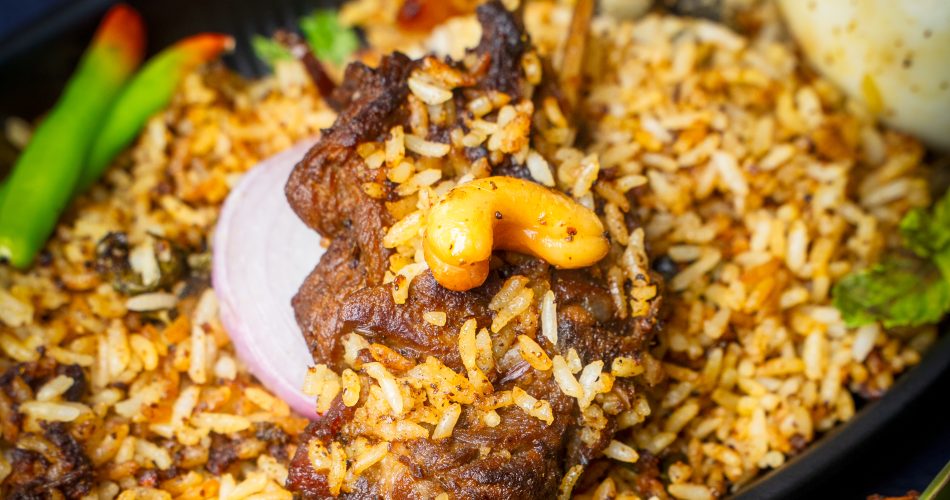Biryani is not just a delicious meal. It’s a phenomenon. It may have begun as a wholesome, nutritious meal for the workers and warriors in the Mughal era. But today, the slow-cooked dish is universally loved.
A sampling of our most popular types of biryanis
The origins of biryani are up for debate, but most agree that it was the Persian pilaf, or “birinj,” that gave birth to it in the royal kitchens of the Mughals. As the recipe travelled with khansamahs across India, it got regionalised, with a mix of native spices and ingredients being layered with rice.
That gave rise to different types of biryanis. Today, travel from our mountain
peaks through the plains to the tips of our sea shores, and you’ll be served a new
kind of biryani.
By rough estimates, there are about 19 to 20 types of biryanis, each subtly
different. There is Lucknowi biryani, with its delicate flavours appealing to a
mild palate. There is biryani made in bamboo by the Adivasis of Araku in
Andhra Pradesh. There is Hyderabadi biryani, cooked with bundles of spices
and full of heat.
The main ingredients stay the same for all. But the flavour, aroma, and look
reflect the region, making each biryani unique. Take the Goan fish biryani. It’s
cooked with a light variety of mackerel, black kokum, grated coconut, and
whole aromatics. In contrast, Bombay biryani, with its Iranian influence, is
sweeter.
It’s not just regions that bring many flavours to types of biryani. How the rice
and meat are cooked makes a world of difference too, creating more variations.
The kacchi method cooks the rice and raw meat together, marrying their
flavours. Whereas, the pukka method cooks them separately first and then mixes
them.
Listing down all the different types of biryani would exhaust an ocean of ink.
So, for the sake of brevity and our craving stomachs, we stick to the most
popular.
Awadhi or Lucknowi biryani
When it comes to aroma and flavour, nothing beats Lucknowi biryani. Cooked
pukka style and with yoghurt, it has a softer texture, and because it uses spices
like cinnamon and star anise (along with the usual suspects), it’s milder.
So, every morsel is a rainbow of flavours instead of a one-two punch. A close
cousin of Awadhi biryani is Moradabadi biryani but made in the kacchi style. It
combines chicken and basmati with a potli of spices that often has cumin and
coriander in it.
Hyderabadi biryani
Some say this is the crowning jewel of all biryanis. As a native of Lucknow, this author begs to differ. But that’s a debate for another day. Hyderabadi biryani has a burst of flavours and is most well-known for cooking basmati and raw meat (chicken, goat, or mutton) together. The dish is seasoned with a bundle of spices, making it rich and extremely spicy.
Bombay biryani
For those who prefer something with less heat, Bombay biryani is the obvious choice. The addition of kewra, plum prunes, golden onion, and cardamom lend it a sweet undertone. The use of fried potatoes, irrespective of whether it contains chicken, mutton, or vegetables, also makes it very distinctive.
Kolkata biryani
Although Kolkata biryani can trace its roots to Awadhi biryani, in preparation
it’s similar to Bombay biryani. The use of spices and oil is done with a gentler
hand, making it lighter and, along with meat pieces, it contains fried potatoes.
Rose water imparts an unusual and unique flavour to this style of biryani.
Biryanis of south
Travel southwards, and you’ll discover a treasure trove of even more biryanis.
The preparations vary wildly. There is the Beary Biryani of Mangalore that has
an abundance of green chilli, coconut, and vegetables.
There is a Bhatkali biryani that incorporates seafood along with a medley of
spices and barely uses any oil. Malabar biryani is made with short-grain rice
instead of the typical basmati and marinates the meat, often a fish, in cilantro
and mint, contributing to an intense flavour.
The thing about good biryani of any type: it needs time
It doesn’t matter which type of biryani you love and crave. They are all
addictively delicious, and the reason for it is in the nature of the dish. Biryani is
not a complicated dish to prepare. But it is time-consuming.
If you think you can order biryani and in less than 30 minutes, you’ll have an
incredibly flavourful meal at your table, you’re sorely mistaken. It’s a dish
meant to be cooked over hours. That’s what dum pukht, the technique used to
make biryani, means: “breathe and cook.”
The parboiled rice and marinated meat (raw or cooked) are placed in a heavy-
bottom pan, sealed tightly and then slow-cooked over a low flame, so they soak
in the aromas and essence released by the spices and florals.
Of course, you can be a chef who cuts down the time by not browning the
onions enough for caramelization to kick in. Or not marinating the meat
overnight. Or not giving saffron the time to bloom in milk and get the most out
of its flavour or wonderful colour.
That’s what most restaurants do. They rush the process, and as a result, the end
product is not as tasty as you imagined it to be. And that’s the thing about good
biryani.
You need to give it time for the ingredients to rest together and get along.
And once they’re ready, they’ll tell you with their fragrance. It’s a feat of
nature. One, you can’t rush.
So, the next time you feel like ordering any type of biryani, have patience. Give
the chef a 24-hour notice to build up the layers of flavour, aroma, texture, and
colour so you get a dish deserving of a celebration.
Order now!

